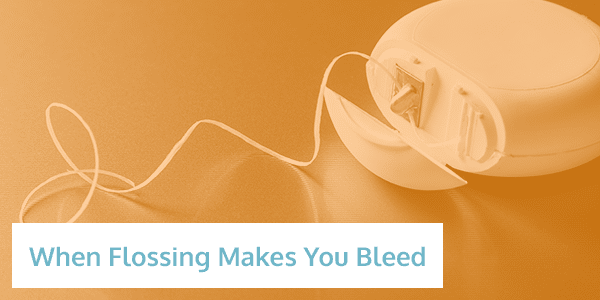When Flossing Makes You Bleed
 Do your gums bleed when flossing? If so, it’s not a signal to cut back. When flossing makes you bleed – as counterintuitive as it may sound – it’s often a signal that you need to do it more frequently.
Do your gums bleed when flossing? If so, it’s not a signal to cut back. When flossing makes you bleed – as counterintuitive as it may sound – it’s often a signal that you need to do it more frequently.
Only about 40 percent of Americans floss every day, according to an American Dental Association study. Flossing daily is an essential part of everyone’s oral hygiene routine. Flossing removes particles of food and bacteria between teeth that a toothbrush can’t reach.
Need a cleaning and oral health check? Fill out a simple contact form and we will connect with you!
Sometimes, bleeding gums are just a sign that your tissue is just adjusting to regular flossing. If you’re not flossing frequently enough, it’s time to become part of the minority who do it daily. The more you floss, the less your gums bleed.
Causes of bleeding gums when flossing:
- Beginning a new flossing routine
- Use of blood-thinning medication
- Poor nutrition, especially a vitamin C or K deficiency
- Improper flossing technique
- Gingivitis or periodontitis
- Pregnancy gingivitis caused by increased sensitivity to plaque bacteria brought on by hormonal changes
Bleeding gums are actually a common sign of periodontal disease, or gum disease, which is a serious mouth disease that puts you at risk of losing teeth among other health complications. Recognizing that your gums bleed when you floss is means it’s time to take charge of your oral health.
“Why do my gums bleed when I floss?”
Healthy gums will hug your teeth which forms a barrier against bacteria looking to invade. They are pink normally and by nature don’t bleed when you brush or floss.
The most common reason your gums bleed after you floss is periodontal disease, which includes gingivitis (the milder form of gum disease) and periodontitis.
Gingivitis develops when bacteria from your food gradually becomes plaque that builds up on your teeth and along the gumline. This plaque hardens into tartar, increasing the risks of periodontitis.
This plaque, tartar, and bacteria at the gumline will cause your gums to become irritated and inflamed, turning them to a paler shade of pink. It is these swollen and infected gums that bleed when you try to floss.
Bleeding After Flossing vs After Brushing
Don’t confuse bleeding gums after flossing with bleeding gums after you brush, or just bleeding gums in general. Bleeding gums can be a symptom of gingivitis, which is the first stage of the disease. From there, it may spread deeper into tissues, and severely impact your oral health – up to tooth loss. In addition to bleeding gums, signs of gum disease include pus between teeth, receding gum line, bad breath and loose and shifting teeth.
If your gums are bleeding as they acclimate to your improved flossing regimen, you may also consider using an antibacterial mouthwash. Mouth rinses prevent bacteria that harden to produce plaque, and can help kill bacteria remaining on your gum tissue.
Bleeding gums isn’t just an issue of oral health: New studies show a link between gum disease and heart disease. Researchers aren’t exactly sure why this is yet, but most agree that strong oral hygiene habits are now part of a heart-smart lifestyle.
It has been shown that periodontitis can result in:
- Stroke
- Diabetes
- Heart disease
These are obviously very serious conditions that can threaten your life. Thankfully, regular flossing and dental checkups can protect your gums and your overall health.
The Solution to Bleeding Gums: Proper Flossing
Flossing, when done correctly, can get at the plaque between your teeth and below your gums to stop tartar buildup.
Begin with roughly 2 feet of dental floss, wrapping it around fingers such that you end up with about 2 inches of floss to work with.
Simply slide the dental floss back and forth between your teeth, then move it below your gums (without cutting them) by pushing it against the side of your tooth and moving the floss up and down.
Keep the floss between your tooth and gum tissue. Gently hold the floss against your tooth and scrape the tooth upward. Do this for each tooth, twice on each side of the tooth.
Again, light bleeding is normal when you first begin a new flossing regimen. Watch for your gums to stop bleeding in a few minutes and within 3 to 10 days of regular flossing.
Heavy, persistent bleeding could be a sign that you aren’t flossing properly or you may have an underlying oral condition. In either case, you should schedule a dental checkup right away.
Put A Stop to Bleeding Gums with a Checkup at Alpine Dental Health
When flossing makes you bleed, it’s a sign you need to make changes. While these may be simple, if gum disease is advanced, you’ll need to speak with a dentist. Visit our Request an Appointment page to start scheduling yours.
